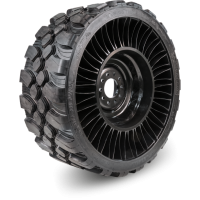Forklift
-
 31.5X13N16.5 MICHELIN X-TWEEL TMF31.5-13.00-16.5 MICHELIN TWEEL - AIRLESS 10-140MM +46MMItem #: 05972Availability: 3More Info...More InformationAdditional InfoFOR FITMENT CONFIRMATION VISIT https://tweel.michelinman.com/tweel-fitment-guide.htmlBearing-Bolt Pattern10-140 MMBox Quantity-BrandMICHELINCenter Bore in/mm-ConstructionAIRLESS RADIALCountry of OriginUSADiameter31.5FinishBLACKHub Length-Industry Code-Load Index139Load/Speed Index-Machine Fitment/ApplicationTRUCK-MOUNTED FORKLIFT, HIAB MOFFETT M8 NXMax Load Capacity (Lbs)5310Max PSI-Mounted Diameter (Inch)31.5Pattern/Position-Ply/Load Index/Star Rating-Ratio13Rim Diameter16.5Rim Size16.5X13Rim Width13Rolling Circumference-Section Width13Size31.5-13-16.5Speed Rating/Speed (MPH)-Static Loaded Radius (inch)-StyleTWEEL FORKLIFTSurface / TerrainALL TERRAINTread Depth (32nds)26/32Tread Width-Tube Type / TubelessAIRLESSTypeTWEELValve-Weight (Lbs.)214.000000Wheel Back Spacing in/mm4Wheel Front Spacing in/mm-Wheel Offset in/mm+46MM
31.5X13N16.5 MICHELIN X-TWEEL TMF31.5-13.00-16.5 MICHELIN TWEEL - AIRLESS 10-140MM +46MMItem #: 05972Availability: 3More Info...More InformationAdditional InfoFOR FITMENT CONFIRMATION VISIT https://tweel.michelinman.com/tweel-fitment-guide.htmlBearing-Bolt Pattern10-140 MMBox Quantity-BrandMICHELINCenter Bore in/mm-ConstructionAIRLESS RADIALCountry of OriginUSADiameter31.5FinishBLACKHub Length-Industry Code-Load Index139Load/Speed Index-Machine Fitment/ApplicationTRUCK-MOUNTED FORKLIFT, HIAB MOFFETT M8 NXMax Load Capacity (Lbs)5310Max PSI-Mounted Diameter (Inch)31.5Pattern/Position-Ply/Load Index/Star Rating-Ratio13Rim Diameter16.5Rim Size16.5X13Rim Width13Rolling Circumference-Section Width13Size31.5-13-16.5Speed Rating/Speed (MPH)-Static Loaded Radius (inch)-StyleTWEEL FORKLIFTSurface / TerrainALL TERRAINTread Depth (32nds)26/32Tread Width-Tube Type / TubelessAIRLESSTypeTWEELValve-Weight (Lbs.)214.000000Wheel Back Spacing in/mm4Wheel Front Spacing in/mm-Wheel Offset in/mm+46MM
What Are Forklift Tires?
Forklift tires are specialized tires designed to meet the unique demands of forklift operations across various industries. These tires must be capable of handling heavy loads, provide stability, ensure maneuverability, and offer durability in environments that range from smooth warehouse floors to rough outdoor surfaces. Forklift tires come in several types, including cushion (solid) tires typically used indoors on smooth surfaces and pneumatic (air-filled) tires for outdoor use on rougher terrain. There are also solid pneumatic tires that offer a compromise between the two, providing the durability of solid tires with the ground comfort of pneumatic tires.
The tire choice for a forklift depends on factors such as the operating environment, load capacity, and the specific needs of the handling tasks, making it crucial for operators to select the right type of tire to ensure safety, efficiency, and cost-effectiveness.
Designs and Features of Forklift Tires
Forklift tires have designs and features adapted to various operational requirements:
- Cushion Tires: These are usually made of solid rubber and are pressed onto the wheel. They have a smaller turning radius and are ideal for applications with space constraints, such as indoor warehouses.
- Pneumatic Tires: Air-filled and designed with deep treads, pneumatic tires provide cushioning and are better suited to uneven outdoor surfaces where shock absorption is important.
- Solid Pneumatic Tires: Combining the benefits of both cushion and pneumatic tires, these are puncture-proof and offer better durability than traditional pneumatic tires for rough terrain without the risk of deflation.
- Non-Marking Tires: Made from a non-marking rubber compound, these tires are used in applications where floor cleanliness is essential, such as in food processing or pharmaceuticals.
- Tread Patterns: Tread designs vary depending on the tire type, with some designed for maximum traction on slippery surfaces and others optimized for minimal floor impact.
- Specialty Tires: These may include anti-static tires used in environments where static discharge could be hazardous or polyurethane tires favored for their load-bearing capacity and resistance to rolling resistance.
Applications and Uses of Forklift Tires
Forklift tires are essential components across diverse settings:
- Warehouses and Distribution Centers: Cushion tires are often used for indoor forklifts that transport goods on smooth concrete floors.
- Outdoor Yards and Construction Sites: Pneumatic tires are preferred for outdoor forklifts working on rough, uneven ground where greater shock absorption is needed.
- Mixed-Environment Facilities: Solid pneumatic tires are chosen for facilities where forklifts transition between indoor and outdoor environments, requiring versatility.
- Clean Rooms and Specialty Manufacturing: Non-marking tires prevent floor scuffs and contamination, crucial in clean rooms or manufacturing plants with strict hygiene standards.
- Chemical and Hazardous Material Handling: In settings where static electricity poses a risk, anti-static forklift tires help to minimize potential sparks or discharges.
- High-Intensity Operations: Polyurethane tires are selected for high-intensity operations where forklifts carry heavy loads over long shifts, as they offer longevity and low rolling resistance.
Forklift tires are a key factor in the safe and efficient operation of forklifts, as they directly impact handling and performance characteristics. The proper selection and maintenance of forklift tires contribute to operational efficiency, safety, and the longevity of the forklift itself. Whether navigating narrow warehouse aisles or moving materials on rugged outdoor terrain, choosing the right forklift tire ensures that the job is done effectively while minimizing wear and tear on the vehicle.
